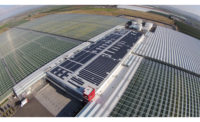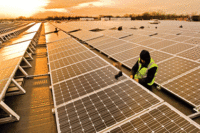Usually when something is free, you ask, “so what’s the catch?” But, when it comes to solar roofing systems, there is no catch. That’s because once the solar roofing system has been paid for, it essentially gives off “free” electricity.
“This is a concept that takes some people a while to comprehend since we are all used to purchasing our electricity and being completely dependent on the utility company for our energy pricing,” says Seth Pepper, principal for Agriculture Energies, LLC, Tucson, Ariz.
With solar roofing systems, that’s no longer the case, as today’s solar roofing technologies offer almost every benefit under the sun.
For example, Agriculture Energies developed Agriculture SolarSun Tracking, a modular roofing system that can be secured at a tilt angle of 0 degrees, resulting in lower wind load than with systems set at an angle. The tough construction is designed to handle constant exposure to water and fertilizers, and increases production of each panel by more than 25% with tracking of the sun.
“Solar makes sense on many levels,” adds Pepper. “We have the ability to not penetrate the roof’s membrane. By using a counter-balanced weight system, the solar array only rests on the roof. The solar panel modules are able to withstand golf ball-sized hail at 100 miles an hour. So, even in the extreme environmental conditions, the system is expected to run untouched for decades to come.”
REC Solar, San Luis Obispo, Calif., completed a 1 MW solar energy system for Vignolo Farms, a grape and potato grower based in Shafter, Calif. The solar array is expected to offset 75% of the farm’s energy use at its cold storage facility while reducing its carbon footprint.
REC Solar also utilizes lightweight racking equipment to reduce the load on rooftops.
“Refrigerated facilities are significant energy hogs with limited roof space,” says Ryan Park, director of business development. “Their rooftops are often loaded with heavy equipment. We also use advanced products such as panel inverters and string optimizers, which enable flexible design that maximizes system performance.”
In another corner of the industry is a group of cold food processors who are concerned with system maintenance and water usage. To address these concerns, Solar Shield, Inc., Blythewood, S.C., provides evaporative roof and truck trailer cooling system that boast automation and convenience.
“First, the system is completely automated, requiring little or no attention during operation. It can be programmed to operate during certain times of the day or days of the week,” says John Strait III, lead sales representative. “To effectively address the water usage problem, every system control scheme comes with a programmable thermostat. This component ensures that the system only operates when complete evaporation can take place. The thermostat prevents the indiscriminate use of water and keeps it from ‘pooling’ on the roof.”
Solar Shield also offers a web-based system and smartphone app, so users can monitor their roof cooling systems via smartphones, tablets or computers.
How solar sheds some light on a bright future
Solar systems are becoming less expensive thanks to increased competition from China, says Gary Gerber, president and CEO of Sun Light & Power, Berkeley, Calif. But, for cold food plants and warehouses, it can be difficult to reduce energy consumption since refrigeration equipment is often needed the most during the daytime summer hours.
“Fortunately, a new incentive program now exists in California, which will pay owners a significant rebate for installing battery storage devices combined with PV or other renewable power,” Gerber says. “This is a very effective combination because the peak production of the PV system’s electricity is often coincident with the occurrence of a peak demand event. As carbon trading, Renewable Portfolio Standards and clean energy mandates become more and more the norm, solar energy is going to soon supplant fossil power as the predominant power source for California and eventually the entire country.”
Plus, there are extra points to be earned that can be used toward a company’s LEED certification, says Pepper.
“Combining the solar with parking canopies can keep your customers and employees happy with added-value shading of their vehicles along with easy integration of electric vehicle charging stations for both transportation cars and warehousing heavy-duty equipment,” he adds.
Installing a solar system may be costly at first, but after it’s paid for, it essentially offers “free” energy. It’s time to let the sun shine in.







